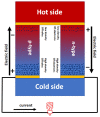Advancing Thermoelectric Materials: A Comprehensive Review Exploring the Significance of One-Dimensional Nano Structuring
- PMID: 37446526
- PMCID: PMC10343789
- DOI: 10.3390/nano13132011
Advancing Thermoelectric Materials: A Comprehensive Review Exploring the Significance of One-Dimensional Nano Structuring
Abstract
Amidst the global challenges posed by pollution, escalating energy expenses, and the imminent threat of global warming, the pursuit of sustainable energy solutions has become increasingly imperative. Thermoelectricity, a promising form of green energy, can harness waste heat and directly convert it into electricity. This technology has captivated attention for centuries due to its environmentally friendly characteristics, mechanical stability, versatility in size and substrate, and absence of moving components. Its applications span diverse domains, encompassing heat recovery, cooling, sensing, and operating at low and high temperatures. However, developing thermoelectric materials with high-performance efficiency faces obstacles such as high cost, toxicity, and reliance on rare-earth elements. To address these challenges, this comprehensive review encompasses pivotal aspects of thermoelectricity, including its historical context, fundamental operating principles, cutting-edge materials, and innovative strategies. In particular, the potential of one-dimensional nanostructuring is explored as a promising avenue for advancing thermoelectric technology. The concept of one-dimensional nanostructuring is extensively examined, encompassing various configurations and their impact on the thermoelectric properties of materials. The profound influence of one-dimensional nanostructuring on thermoelectric parameters is also thoroughly discussed. The review also provides a comprehensive overview of large-scale synthesis methods for one-dimensional thermoelectric materials, delving into the measurement of thermoelectric properties specific to such materials. Finally, the review concludes by outlining prospects and identifying potential directions for further advancements in the field.
Keywords: electrical conductivity; figure-of-merit; materials; nanostructuring; one dimensional; seebeck coefficient; thermal conductivity; thermoelectric.
Conflict of interest statement
The authors declare no conflict of interest.
Figures


















References
-
- Eight Billion People, One Humanity; Development Milestone ‘Testament’ to Power of Health and Science. [(accessed on 16 November 2022)]. Available online: https://news.un.org/en/story/2022/11/1130417.
-
- Corbyn Z. A Container-Sized Generator that Converts Waste Heat into Energy. [(accessed on 16 November 2022)]. Available online: https://www.theguardian.com/technology/2014/dec/07/1-alphabet-energy-gen....
-
- Wang C., Tang S., Liu X., Su G., Tian W., Qiu S. Experimental study on heat pipe thermoelectric generator for industrial high temperature waste heat recovery. Appl. Therm. Eng. 2020;175:115299. doi: 10.1016/j.applthermaleng.2020.115299. - DOI
-
- Zhang Y., Cleary M., Wang X., Kempf N., Schoensee L., Yang J., Joshi G., Meda L. High-temperature and high-power-density nanostructured thermoelectric generator for automotive waste heat recovery. Energy Convers. Manag. 2015;105:946–950. doi: 10.1016/j.enconman.2015.08.051. - DOI
Publication types
Grants and funding
LinkOut - more resources
Full Text Sources

